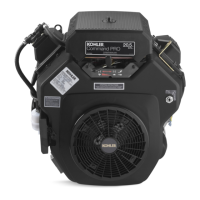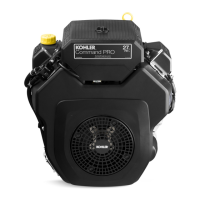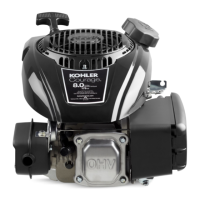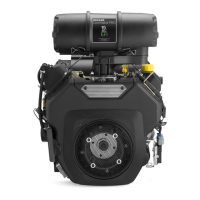5
LPG Operation
Installation of jet in regulator fi ing is required for
LPG operation.
Switching from NG to LPG
NOTE: When switching from NG to LPG fuel, the
ba ery must be temporarily disconnected for safety
and to reset the system.
Remove the fuel inlet hose. Inspect the internal threads
of regulator fi ing to ensure they are clean and dry.
Install jet into the fuel elbow orifi ce for LPG operation.
See Figure 4. Reconnect and fully tighten the fuel inlet
hose.
NOTE: Turn on fuel supply and check all fuel line
connections with soapy water before starting
or pu ing engine/system into service.
Outlet pressure should be checked and if required, set
at the secondary regulator to 4.0 to 5.0 PSI by qualifi ed
personnel.
NG Operation
Removal of jet from regulator fi ing is required for
NG operation.
Switching from LPG to NG
NOTE: When switching from LPG to NG fuel, the
ba ery must be temporarily disconnected for safety
and to reset system.
Remove the LPG fuel jet from the regulator fi ing.
Disconnect the hose, remove the jet from the orifi ce
(Figure 4), and reconnect the hose.
NOTE: Turn on fuel supply and check all fuel line
connections with soapy water before starting
or pu ing engine/system into service.
Recommended fuel inlet pressure for NG systems is 11
in. water (engine off ). Reduced pressure could result
in hard starting.
Figure 4. Fitting and Jet.
LPG Engines
LPG from an appropriate LPG fuel tank (supplied
separately) is required to operate this engine.
WARNING: Pressurized LPG!
Fuel tanks are fi lled under pressure and should be handled
with care. To prevent tank damage which could endanger the
safety of the operator or persons in the area, do not drop or
drag tanks on any surface. Use a hand truck when moving,
or tilt the tank on its footring in a position slightly off
vertical and roll it.
Avoid personal contact with LPG fuel to prevent frostbite.
See a physician if frostbite occurs.
WARNING: Explosive Fuel!
LPG is extremely fl ammable, is heavier than air and tends
to se le in low areas where a spark or fl ame could ignite the
gas. Do not start or operate this engine in a poorly ventilated
area where leaking gas could accumulate and endanger the
safety of persons in the area.
LPG fuel consists primarily of propane, although the fuel
supplier may sometimes mix other gases with propane.
Fuel tanks must be fi lled only by persons qualifi ed in the
handling of LPG. Tanks are fi lled by weight and should not
be overfi lled (never to more than 80 percent of total capacity).
An air space must be present in the tank to allow fuel to
expand.
Tanks must be removed from equipment before fi lling.
NG Engines
NG from an approved system or source of supply can
be used to operate this engine.
WARNING: Explosive Fuel!
NG is extremely fl ammable, is lighter than air, and rises. Do
not start or operate this engine in a poorly ventilated area
where leaking gas could accumulate and endanger the safety
of persons in the area.
Fuel Conversion
Some engines are equipped to convert between LPG
and NG. The models with the fi ing and jet shown
below should follow these instructions for conversion.
Other metering valves should be installed following
the instructions given by the equipment it powers. Shut
off fuel supply before any servicing is performed.
NOTE: Engines with a DSAI system will have leads
located near the fuel regulator. Connect the
leads for NG and leave disconnected for LPG.

